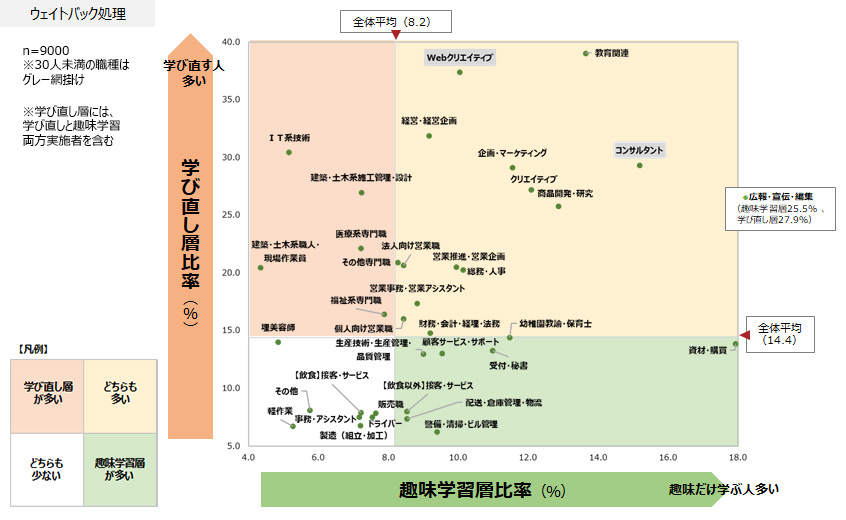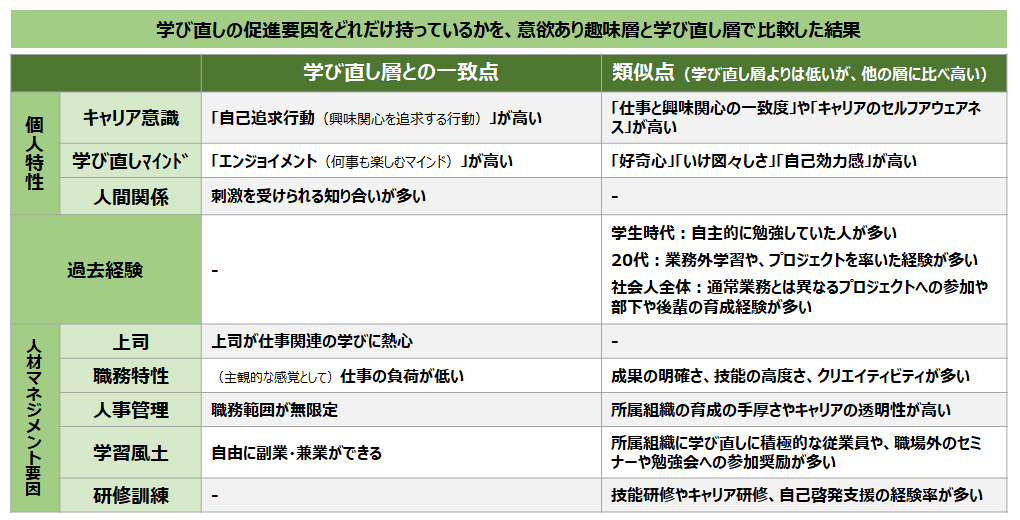Actual conditions of learning as it pertains to the hobbies of middle-aged and senior workers and what can be done to use this attitude to learning for retaining purposes
Release Date:

※This article is a machine translation.
Reskilling is drawing more attention in response to government commitments to expand support. However, fewer Japanese workers voluntarily enroll in learning activities compared to other advanced countries; this is especially true of middle-aged and senior workers.
On the other hand, a certain number of middle-aged and senior workers enjoy hobbies outside of work. Perhaps the learning required for such hobbies can serve as a starting point for relearning in the furtherance of a job or career.
It is from this standpoint that we conducted a Quantitative Survey on Learning and Working Lives of Middle-aged and Senior Workers [Part 2]. In this column, we will outline the characteristics of middle-aged and senior workers who actively acquiring new skills and knowledge for their hobbies as revealed by this survey and the strategies that can be used to leverage this attitude toward learning as it pertains to hobbies for retaining purposes.*1
*1 In this column, we define learning outside of work related to work and careers as “learning again”.
Index
- Re-learning at work is a big hurdle
- 12.6% of middle-aged and senior workers learn a hobby
- The spillover effect of learning a hobby on work
- Middle-aged and senior workers who learn a hobby are similar to middle-aged and senior workers who learn again
- Learning a hobby can be a starting point for learning again
- Summary
Re-learning at work is a big hurdle
14.4% of middle-aged and senior workers (“re-learning” group) are continuously learning about work and careers outside of work hours. As the age group increases, the percentage decreases. However, the “talking only” group, who want to learn but have not yet taken action, is higher at 29.8%.
In addition, around 70% of middle-aged and senior workers responded positively to the statement “In this day and age, it is necessary to continue learning no matter what your age”. The recognition that there is value in relearning is widely accepted, but whether or not this translates into action is another matter.
The reasons given by the “talking only” group for not taking action were “I don’t have the money to learn”, “I can’t make the time to learn”, and “I don’t have the mental space to learn”, with a lack of financial, time, and mental space topping the list (about 30% each). This shows that there are many middle-aged and senior workers who want to learn for their future careers and work, but who don’t have the time to spare from their private lives.
12.6% of middle-aged and senior workers learn a hobby
On the other hand, 12.6% of middle-aged and senior workers were learning a hobby on a continuous basis. In this survey, we counted those who answered that they were “continuously learning outside of work hours”, and did not include those who were engaged in hobby activities after work but did not consider them to be continuous learning. Of these, we named those who were not learning about work but were continuously learning about their hobby as the “hobby learners” group. The “hobby learners” group accounts for 8.2% of middle-aged and senior workers (Figure 1).
Figure 1: Percentage of middle-aged and senior workers who study their hobbies
Source: Persol Research and Consulting + Saito Laboratory, Sanno University(2024)Quantitative Survey on Middle-Aged and Senior Workers’ Learning and Working Lives [Part 2]
What exactly are the ‘hobby learners’ group studying? The most popular subject was English, at around 15%,
followed by languages, music, other sports*2, and asset formation/asset management (Figure 2). There were
differences between men and women, with men tending to study asset formation/asset management, history, IT, and
sports, while women tended to study languages, English, music, handicrafts/DIY, and calligraphy.
Figure 2: Learning content of hobbies
*2. Responses related to sports other than golf, martial arts, muscle training, tennis, running, dance, soccer, and baseball. This includes responses such as “sports” where the name of the sport is not stated.
Source: Persol Research and Consulting + Saito Laboratory, Sanno University(2024)Quantitative Survey on Middle-Aged and Senior Workers’ Learning and Working Lives [Part 2]
The spillover effect of learning a hobby on work
In some cases, hobbies can be put to use in the workplace. When the “hobby learners” group was asked about the effects of their hobbies on their work and income, the most common response was “I have more human relationships” (about half of the respondents), but around 40% also felt that “I have less anxiety about my future life” and “my motivation for work has increased”. This shows that many people feel that their hobbies have a positive effect on their motivation for work and life in the future.
Figure 3: The ripple effect of learning a hobby on work and income
Source: Persol Research and Consulting + Saito Laboratory, Sanno University(2024)Quantitative Survey on Middle-Aged and Senior Workers’ Learning and Working Lives [Part 2]
The background to how hobbies lead to work and income is influenced by the level of proficiency in the hobby,
the content of the hobby, and the way in which it is studied.
Of middle-aged and senior workers (6% of the “hobby learners” group) who answered that their hobby proficiency was “rewarding/recognized by society”, more than half felt that it had an effect on their work and income. This suggests that people who have mastered their hobbies often find that they lead to additional income or are put to use in their main job.
However, depending on the content of the hobby, some hobbies are more likely to lead to a source of income than others. The top hobby that is most likely to lead to a source of income is “asset formation and asset management” (Figure 4). Learning about insurance and stock investment will in many cases lead to income. In addition, there are many ways to earn extra income in similar fields such as “economics and finance”, “science and technology/engineering” (including mechanical and electrical engineering), “nursing care” and “IT”, and these are also fields that are likely to lead to income. On the other hand, “religion”, “reading in general” and “history” are less likely to lead to income.
In addition, there was a tendency for those who participate in communities and learn with their peers to be more likely to lead to work and income. It is thought that information and connections from friends who are not related to work can also be useful in work.
Figure 4: Ease of connecting to sources of income by hobby learning content
Source: Persol Research and Consulting + Saito Laboratory, Sanno University(2024)Quantitative Survey on Middle-Aged and Senior Workers’ Learning and Working Lives [Part 2]
Learning for hobbies tended to be more enjoyable than learning for work in the short term. It is said that
forming “learning habits” is important for continuing to learn. For both learning for hobbies and learning for work,
the learning methods are often through books or the internet, and there is not much difference. First of all,
through learning a hobby in a fun way, for example, learning habits such as reading on Sunday mornings can be
acquired, and this can be applied to relearning work in the future.
Middle-aged and senior workers who learn a hobby are similar to middle-aged and senior workers who learn again
Middle-aged and senior workers who study hobbies are similar to middle-aged and senior workers who relearn about work and careers. Figure 5 shows which types of work and hobbies are most common for each group, with the “hobby learners” group plotted on the right and the “relearners” group plotted on the top.
For example, we can see that there are many people in both the “re-learning” and “hobby learners” groups in intellectual and creative occupations such as “public relations, advertising and editing”, “consultancy”, “education-related”, “web creative” and “product development and research”. This is thought to be due to the fact that these are occupations where individuals’ curiosity and motivation to learn are naturally high, and also because it is easy to apply what you have learned as a hobby to your work.
On the other hand, there are many “IT-related technical jobs” and “construction/civil engineering jobs” in the “re-learning” group, but few in the “hobby learners” group. These are types of jobs where people study about their work outside of work hours in order to obtain qualifications and improve their skills. The “materials/purchasing”, “reception/secretarial”, and “kindergarten teacher/nursery school teacher” jobs have many “hobby learners” but few “re-learners”.
In addition, the higher the educational background or position, the more likely it is that you will find both “re-learning” and “hobby learners” groups.
Figure 5: Percentage of “hobby learners” and “re-learners” by occupation
Source: Persol Research and Consulting + Saito Laboratory, Sanno University(2024)Quantitative Survey on Middle-Aged and Senior Workers’ Learning and Working Lives [Part 2]
Looking at the data so far, it seems that there is some overlap between the “re-learning” group and the “hobby
learners” group. The survey identified various factors that encourage middle-aged and senior workers to re-learn
(such as their attitude to learning as students, career awareness, interpersonal relationships, experience of
attending educational training courses, and the characteristics of their jobs), and in all cases, the “hobby
learners” group tended to be similar to the “re-learning” group (Figure 6).
Figure 6: Characteristics of the “motivated hobbyists” group compared to the “re-learning” group (comparison of factors that promote re-learning)
Source: Persol Research and Consulting + Saito Laboratory, Sanno University(2024)Quantitative Survey on Middle-Aged and Senior Workers’ Learning and Working Lives [Part 2]
In particular, the “motivated hobby learners” group, who have the desire to re-learn but only study their
hobbies, tended to have many factors that encouraged them to re-learn. Among these, the conditions “the ability to
pursue things that interest you”, “stimulating personal relationships”, “a boss who is enthusiastic about learning”,
and “a low subjective workload” were common to both the “re-learning” group and the “motivated hobby learners”
group.
The “hobby learners” group has the highest potential for learning outside of work, and could be said to be a potential “re-learning” group. In the first place, it is only natural that people who have the habit of learning outside of work are closer to “re-learning” than the “talking only” group.
Learning a hobby can be a starting point for learning again
With all this in mind, in this day and age when there is so much talk about reskilling, I would like to suggest that learning about your hobbies can be a starting point for relearning about work and careers. In today’s world of rapid change, it is becoming increasingly difficult to draw a line between what kind of learning is directly related to work and what is not.
For individuals, there are two ways to go about it. One is to turn your hobby into a future job or a side business. The other is to use hobby learning as a springboard to develop a learning habit, gradually expanding your interests and also engaging in work and career learning.
For organizations, lowering the hurdle to learning and creating a place where hobby learners can share their learning with others, or learning hobbies together in club activities, can help to stimulate the learning motivation of non-learners and foster a learning culture within the organization. In order to promote relearning, it is important to learn together as an organization and grow together, rather than the traditional approach of individuals studying in secret on their own. Expanding the base of learning and including hobbies in organizational learning activities has the potential to stimulate employees’ motivation to learn, revitalize the company, and lead to unexpected benefits for work.
In addition, the “hobby learners” group tended to have a lower “degree of agreement between work and personal interests” and “understanding of the direction of their own career (career self-awareness)” than the “re-learning” group. In other words, there is room for improvement in making their own career their own. Also, when these were high, there was a tendency for the ripple effect on work and income from hobby learning to be high.
In order to increase the degree of alignment between work and interests, and to raise career self-awareness, it is effective to have companies implement measures to support career autonomy (such as career training and consultation, internal job postings, and a side job system), as well as to carefully manage goals. Through such measures, it is thought that the “hobby learners” group will be encouraged to look at relearning, and that it will become easier for them to make use of their hobby learning in their work.
Summary
In this article, we have looked at the actual situation of hobby learning among middle-aged and senior workers, and suggested that hobby learning could be used to help people relearn. The main points of this article are as follows
● 8.2% of middle-aged and senior workers are “hobby learners” who are continuously studying their hobbies outside
of work.
●Approximately 40% of the “hobby learners” group feel that their hobby learning has helped to
relieve their concerns about their future lives and has increased their motivation at work. The effects of hobby
learning vary depending on the level of proficiency in the hobby, the content of the learning, and the learning
method.
●The “hobby learners” group has many factors that promote re-learning related to work and careers,
and can be positioned as a potential “re-learning” group.
● Hobby learning has the potential to promote
re-learning through helping individuals to develop learning habits and fostering a culture of learning within
organizations. In particular, career autonomy support measures and careful goal management can lead the “hobby
learners” group to focus on re-learning work-related skills and applying their hobbies to their work.
I hope that this column will be of help in the discussion of learning for middle-aged and senior workers.
THEME
注目のテーマ
CONTACT US
お問い合わせ
こちらのフォームからお問い合わせいただけます





